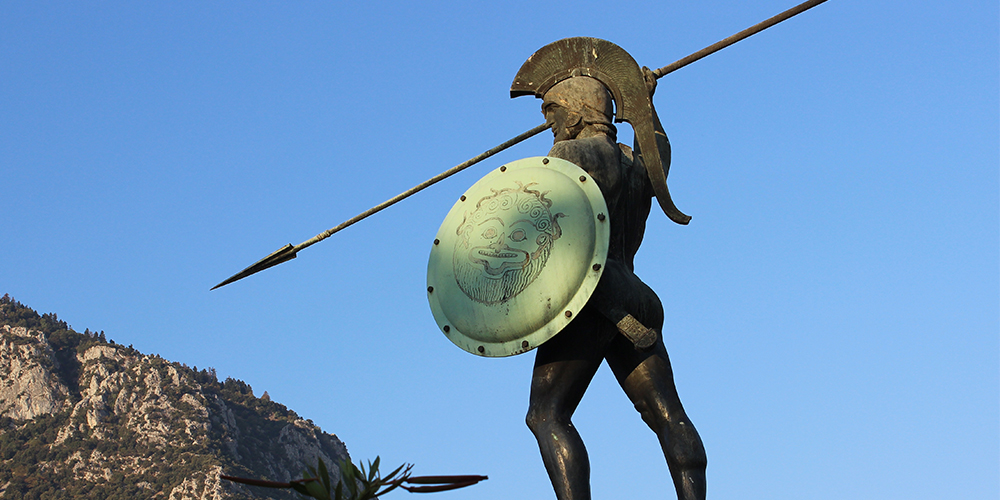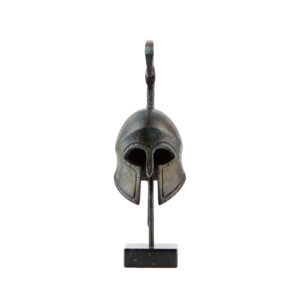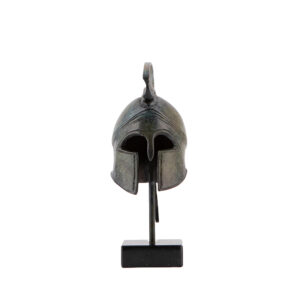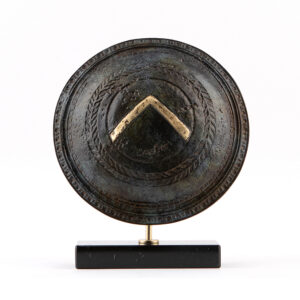
Ancient Greek helmets
"War is the father of all things" said Heraclitus, a philosopher from ancient Ephesus. The term “war” here is used to metaphorically convey the concept of conflict that exists in the universe in general. Nevertheless this phrase could well describe the political situation in Ancient Greece, since conflicts between various Greek populations were frequent.
The first warfare-related findings and depictions date back to the Bronze Age, to the already developing Mycenaean Civilization. We can see the equipment the warriors of the period used on stamp seals and frescoes, while archeological findings help complete our knowledge of ancient Greek weaponry.
The helmet was part of the warrior's defensive equipment. The boar's tusk helmet was a popular type during the Mycenaean era: it was made of leather, wild boar tusks, and felt, protecting the top half of the head down to the forehead. Typical depictions of such a helmet include the frescoes of the so-called "Palace of Nestor" in Pylos.
Corinthian helmet
As we move into the Greek Dark Ages and the Archaic period (9th to 6th centuries B.C.), the use of metal (bronze) to protect the head becomes more widespread. The most recognizable Ancient Greek helmet was worn during this era the Corinthian helmet. As its name indicates, this type seems to have been first developed in Corinth and then spread to the rest of Greece.
The form of this helmet evolved over the years and what began as an early simplistic one, eventually reached an improved anatomical form with holes in the ear area for better hearing during battle. Its decoration also followed these phases of development, so even on the later helmets one can observe embossed and engraved decorative elements such as eyebrows, animals, painted motifs and mythological creatures.
As we can see from vase paintings of the era, a plume of horse hair was usually placed on the top of the helmet, while there were also cases of a raised single, double or even (rarely) triple plume!
Illyrian helmet
This type of helmet was developed around the same time. Surprisingly, its name is not synonymous with its origin: It owes its name to archaeologists who found a large number of such helmets in the area of ancient Illyria. However, northwestern Peloponnese seems to be the original homeland of this type. Like the Corinthian type, it went through various phases of development.
What particularly distinguished the Illyrian type was that it left the face area uncovered, allowing the warrior much better vision. Its use was also widespread among other peoples of the time such as the Illyrians, while its use by the Greeks seems to have stopped around the beginning of the 5th century B.C.
Chalcidian helmet
In the 5th and 4th centuries B.C, the Chalcidian helmet appears. It is so-called because of its oldest depictions, which can be seen on pottery found in the Euboean city of Chalcis. It looks like a variant of the Corinthian type, but is less bulky and lighter, the design trying to improve the warrior's vision and hearing. It also has a small nose guard.
Attic helmet
The Attic helmet was first manufactured in the region of Attica during the Classical period, hence its name. It looked similar to the Chalcidian helmet but didn’t have a nose guard. Its use became more widespread in the Hellenistic and Roman times.
Pilos helmet
The Pilos helmet appeared after the 2nd half of the 5th century in Sparta. It was a helmet that did not resemble any of the others that were developed by Ancient Greeks up to that time. It had a conical shape and protected only the upper part of the head, but since it left the face and the back of the neck uncovered, it gave the wearer much better vision and hearing.
Boeotian helmet
In the 4th and 3rd centuries B.C, the Boeotian helmet was particularly popular among Greek cavalrymen, because –as an open helmet that offered protection only to the top of the head– it offered excellent vision. It was characterized by a wide brim that had "ripples" and "grooves", indicating that the shape of this helmet may have been inspired by a hat of that period!
Phrygian helmet
Another helmet that saw widespread use from the Hellenistic times onwards was the Phrygian or Thracian helmet. Characteristic of its form was the high and forwardly-inclined apex, which ended in a sloping, fist-like shape. Its use was widespread in Thrace, and among the Dacians, while in Greece it was adopted by the Macedonian army of Philip II. The Diadochi (the generals who fought for control over his empire after his death) of Alexander the Great also used this type of helmet.
Discover more
Ancient Greek Helmets: The Good, the Bad, and the Ugly - Pedia Discovery
Helmets on Ancient Greek Coins - CoinWeek
Helmet of the Corinthian Type and Pair of Greaves - TheMet
more moments
Recent Posts
Selected helmets and armor from our collection
Share this:
- Click to share on Twitter (Opens in new window)
- Click to share on Facebook (Opens in new window)
- Click to share on LinkedIn (Opens in new window)
- Click to share on Reddit (Opens in new window)
- Click to share on Tumblr (Opens in new window)
- Click to share on Pinterest (Opens in new window)
- Click to share on Pocket (Opens in new window)
- Click to share on Telegram (Opens in new window)
- Click to share on WhatsApp (Opens in new window)




